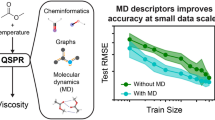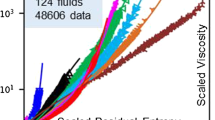Abstract
Liquid viscosity is an important physical property utilized in engineering designs for transportation and processing of fluids. However, the measurement of liquid viscosity is not always easy when the materials have toxicity and instability. In this study, a modified scaled variable reduced coordinate (SVRC)-quantitative structure property relationship (QSPR) model is suggested and analyzed in terms of its performance of prediction for liquid viscosity compared to the conventional SVRC-QSPR model and the other methods. The modification was conducted by changing the initial point from triple point to ambient temperature (293 K), and assuming that the liquid viscosity at critical temperature is 0 cP. The results reveal that the prediction performance of the modified SVRC-QSPR model is comparable to the other methods as showing 7.90% of mean absolute percentage error (MAPE) and 0.9838 of R 2. In terms of both the number of components and the performance of prediction, the modified SVRC-QSPR model is superior to the conventional SVRC-QSPR model. Also, the applicability of the model is improved since the condition of the end points of the modified model is not so restrictive as the conventional SVRC-QSPR model.
Similar content being viewed by others
References
B. E. Poling, J. M. Prausnitz and J. P. O’Connell, The properties of gases and liquids, Mcgraw-hill, NY (2001).
T. Ghosh, D. Prasad, N. Dutt and K. Rani, Viscosity of liquids: Theory, estimation, experiment, and data, Springer, NY (2007).
M. Hobson and J.H. Weber, AIChE J., 2, 354 (1956).
L. Constantinou, R. Gani and J. P. O’Connell, Fluid Phase Equilib., 103, 11 (1995).
H. S. Elbro, A. Fredenslund and P. Rasmussen, Ind. Eng. Chem. Res., 30, 2576 (1991).
B. H. Park, M. S. Yeom, K.-P. Yoo and C. S. Lee, Korean J. Chem. Eng., 15, 246 (1998).
J. Park and D. Paul, J. Membr. Sci., 125, 23 (1997).
D. Sola, A. Ferri, M. Banchero, L. Manna and S. Sicardi, Fluid Phase Equilib., 263, 33 (2008).
P.R. Duchowicz, A. Talevi, L. E. Bruno-Blanch and E. A. Castro, Biorg. Med. Chem., 16, 7944 (2008).
Y. Dadmohammadi, S. Gebreyohannes, B. J. Neely and K. A. Gasem, Fluid Phase Equilib., 409, 318 (2016).
S. S. Godavarthy, R. L. Robinson and K. A. Gasem, Fluid Phase Equilib., 246, 39 (2006).
A.R. Katritzky, V. S. Lobanov and M. Karelson, Chem. Soc. Rev., 24, 279 (1995).
H. Maadani, M. Salahinejad and J. Ghasemi, SAR QSAR Environ. Res., 26, 1033 (2015).
B. Wang, L. Zhou, K. Xu and Q. Wang, Ind. Eng. Chem. Res., 56, 47 (2017).
L.C. Yee and Y.C. Wei, Current modeling methods used in qsar/qspr, Wiley-VCH: Weinheim, Germany (2012).
L. S. Aiken, S. G. West and S. C. Pitts, Multiple linear regression: Testing and interpreting interactions, Sage, CA (1991).
Y. Ammi, L. Khaouane and S. Hanini, Korean J. Chem. Eng., 32, 2300 (2015).
A.A. Babaei, A. Khataee, E. Ahmadpour, M. Sheydaei, B. Kakavandi and Z. Alaee, Korean J. Chem. Eng., 33, 1352 (2016).
E. Mohagheghian, H. Zafarian-Rigaki, Y. Motamedi-Ghahfarrokhi and A. Hemmati-Sarapardeh, Korean J. Chem. Eng., 32, 2087 (2015).
M. Luckas and K. Lucas, AIChE J., 32, 139 (1986).
W.D. Monnery, W.Y. Svrcek and A.K. Mehrotra, Can. J. Chem. Eng., 73, 3 (1995).
A. Jegadeesan, Structure-based generalized models for selected purefluid saturation properties, Oklahoma State University, M.S. Thesis (2006).
R.D. Shaver, New scaled-variable-reduced-coordinate framework for correlation of pure fluid saturation properties, Oklahoma State University, M.S. Thesis (1990).
R. Shaver, R. Robinson and K. Gasem, Fluid Phase Equilib., 64, 141 (1991).
R. Shaver, R. Robinson and K. Gasem, Fluid Phase Equilib., 78, 81 (1992).
M. McHugh and V. Krukonis, Supercritical fluid extraction: Principles and practice, Elsevier (2013).
W. Sauerbrei and M. Schumacher, Stat. Med., 11, 2093 (1992).
E.W. Steyerberg, M. J. Eijkemans and J.D. F. Habbema, J. Clin. Epidemiol., 52, 935 (1999).
R.M. O’brien, Quality & Quantity, 41, 673 (2007).
N. Dutt, Y. Ravikumar and K.Y. Rani, Chem. Eng. Commun., 200, 1600 (2013).
Y. Zhao, X. Zhang, L. Deng and S. Zhang, Comput. Chem. Eng., 92, 37 (2016).
B.-K. Chen, M.-J. Liang, T.-Y. Wu and H. P. Wang, Fluid Phase Equilib., 350, 37 (2013).
R. L. Gardas and J.A. Coutinho, Fluid Phase Equilib., 266, 195 (2008).
Author information
Authors and Affiliations
Corresponding author
Additional information
This article is dedicated to Prof. Ki-Pung Yoo on his honorable retirement from Sogang University.
Rights and permissions
About this article
Cite this article
Lee, S., Park, K., Kwon, Y. et al. A modified scaled variable reduced coordinate (SVRC)-quantitative structure property relationship (QSPR) model for predicting liquid viscosity of pure organic compounds. Korean J. Chem. Eng. 34, 2715–2724 (2017). https://doi.org/10.1007/s11814-017-0173-3
Received:
Accepted:
Published:
Issue Date:
DOI: https://doi.org/10.1007/s11814-017-0173-3




